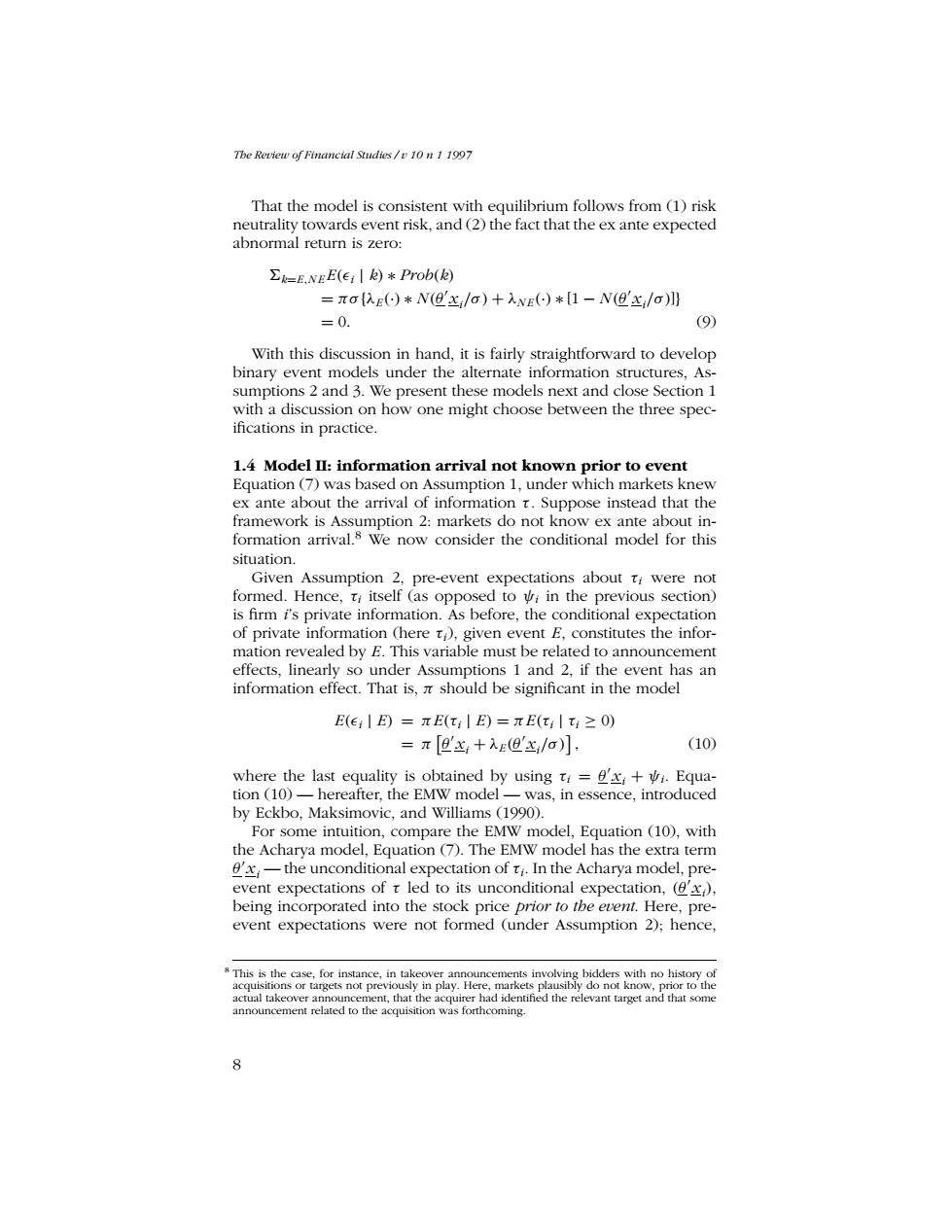正在加载图片...

Tbe Review of Financial Studies /v 10 n 1 1997 That the model is consistent with equilibrium follows from (1)risk neutrality towards event risk,and (2)the fact that the ex ante expected abnormal return is zero: Ek=E.NEE(Eil k)*Prob(k) =πo{2E()*N(E'x,/o)+入NE()*[1-N(E'x/o} =0. (9) With this discussion in hand,it is fairly straightforward to develop binary event models under the alternate information structures,As- sumptions 2 and 3.We present these models next and close Section 1 with a discussion on how one might choose between the three spec- ifications in practice. 1.4 Model II:information arrival not known prior to event Equation (7)was based on Assumption 1.under which markets knew ex ante about the arrival of information t.Suppose instead that the framework is Assumption 2:markets do not know ex ante about in- formation arrival.8 We now consider the conditional model for this situation. Given Assumption 2,pre-event expectations about ti were not formed.Hence,ti itself (as opposed to i in the previous section) is firm i's private information.As before,the conditional expectation of private information (here t,given event E,constitutes the infor- mation revealed by E.This variable must be related to announcement effects,linearly so under Assumptions 1 and 2,if the event has an information effect.That is,should be significant in the model E(e:|E)=πE(t:|E)=πE(t;It1≥0) =π[E'x;+入(@'x/o)】, (10) where the last equality is obtained by using ti=x+i.Equa- tion (10)-hereafter,the EMW model-was,in essence,introduced by Eckbo,Maksimovic,and Williams (1990). For some intuition,compare the EMW model,Equation (10),with the Acharya model,Equation (7).The EMW model has the extra term @'x-the unconditional expectation of ti.In the Acharya model,pre- event expectations of t led to its unconditional expectation,() being incorporated into the stock price prior to the event.Here,pre- event expectations were not formed (under Assumption 2);hence, s This is the case,for instance,in takeover announcements involving bidders with no history of acquisitions or targets not previously in play.Here,markets plausibly do not know,prior to the actual takeover announcement,that the acquirer had identified the relevant target and that some announcement related to the acquisition was forthcoming. 8The Review of Financial Studies / v 10 n 1 1997 That the model is consistent with equilibrium follows from (1) risk neutrality towards event risk, and (2) the fact that the ex ante expected abnormal return is zero: 6k=E,N E E(²i | k) ∗ Prob(k) = πσ{λE (·) ∗ N (θ0 xi/σ ) + λN E (·) ∗ [1 − N (θ0 xi/σ )]} = 0. (9) With this discussion in hand, it is fairly straightforward to develop binary event models under the alternate information structures, Assumptions 2 and 3. We present these models next and close Section 1 with a discussion on how one might choose between the three specifications in practice. 1.4 Model II: information arrival not known prior to event Equation (7) was based on Assumption 1, under which markets knew ex ante about the arrival of information τ . Suppose instead that the framework is Assumption 2: markets do not know ex ante about information arrival.8 We now consider the conditional model for this situation. Given Assumption 2, pre-event expectations about τi were not formed. Hence, τi itself (as opposed to ψi in the previous section) is firm i’s private information. As before, the conditional expectation of private information (here τi), given event E, constitutes the information revealed by E. This variable must be related to announcement effects, linearly so under Assumptions 1 and 2, if the event has an information effect. That is, π should be significant in the model E(²i | E) = πE(τi | E) = πE(τi | τi ≥ 0) = π £ θ0 xi + λE (θ0 xi/σ )¤ , (10) where the last equality is obtained by using τi = θ0 xi + ψi. Equation (10) — hereafter, the EMW model — was, in essence, introduced by Eckbo, Maksimovic, and Williams (1990). For some intuition, compare the EMW model, Equation (10), with the Acharya model, Equation (7). The EMW model has the extra term θ0 xi — the unconditional expectation of τi. In the Acharya model, preevent expectations of τ led to its unconditional expectation, (θ0 xi), being incorporated into the stock price prior to the event. Here, preevent expectations were not formed (under Assumption 2); hence, 8 This is the case, for instance, in takeover announcements involving bidders with no history of acquisitions or targets not previously in play. Here, markets plausibly do not know, prior to the actual takeover announcement, that the acquirer had identified the relevant target and that some announcement related to the acquisition was forthcoming. 8